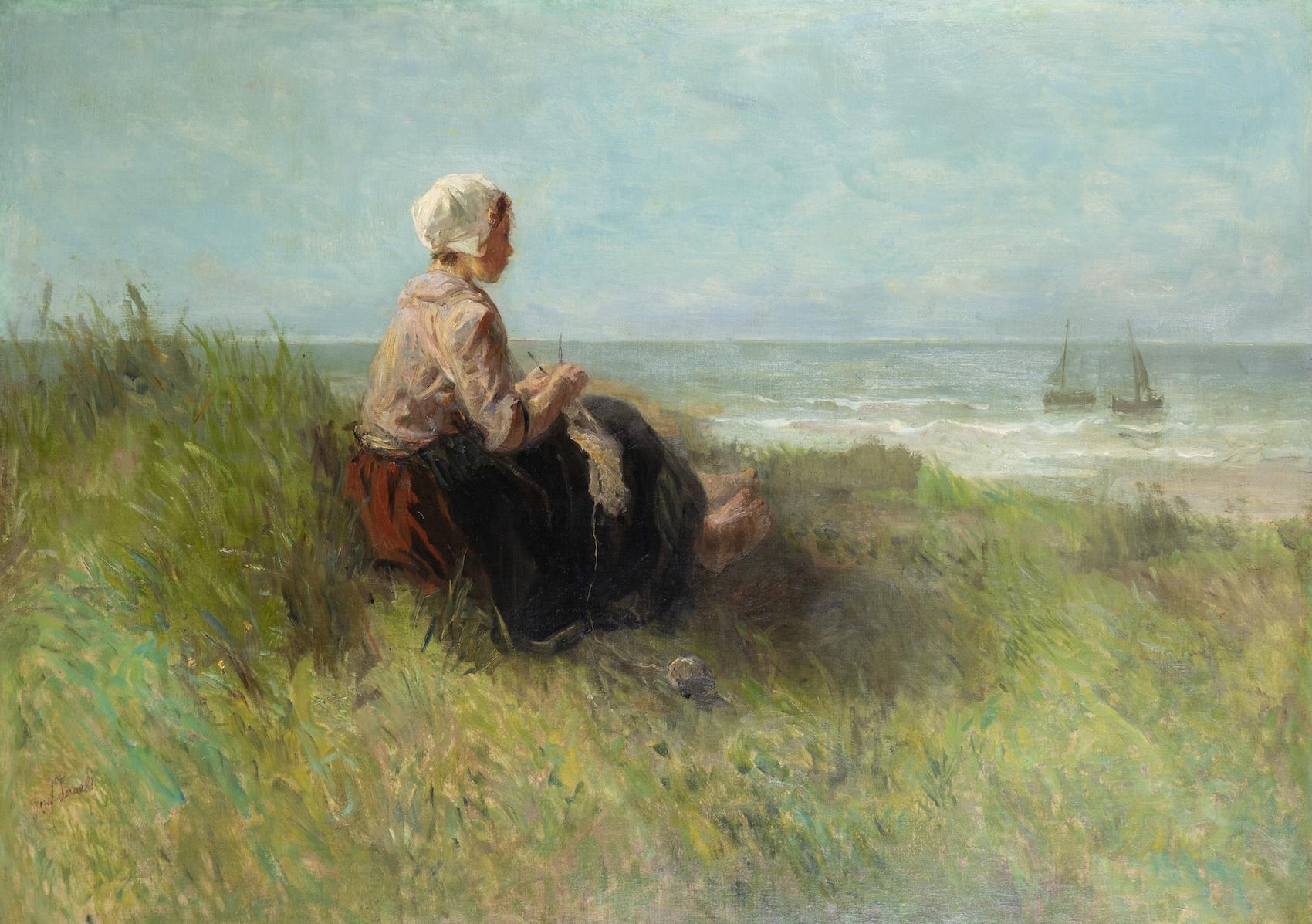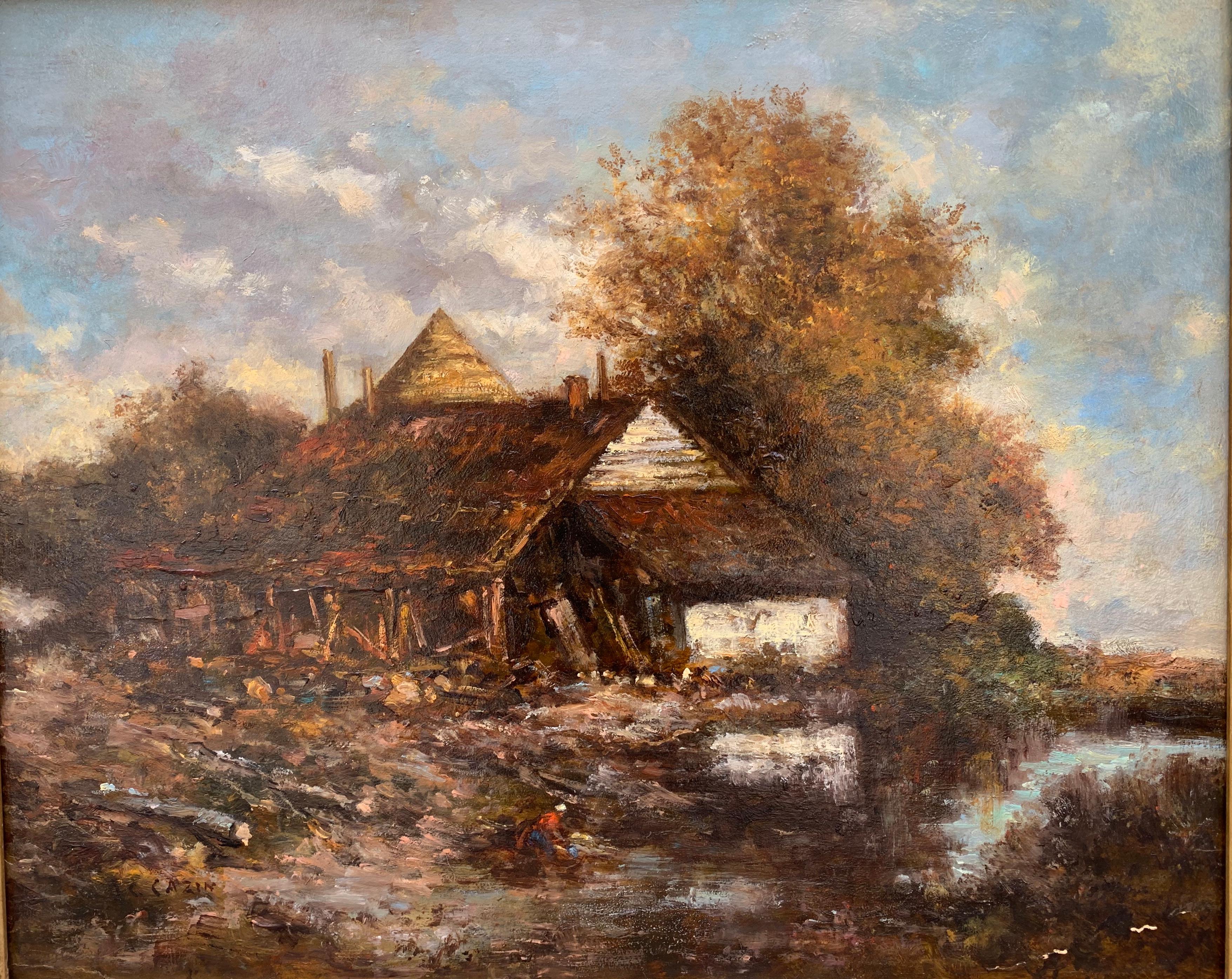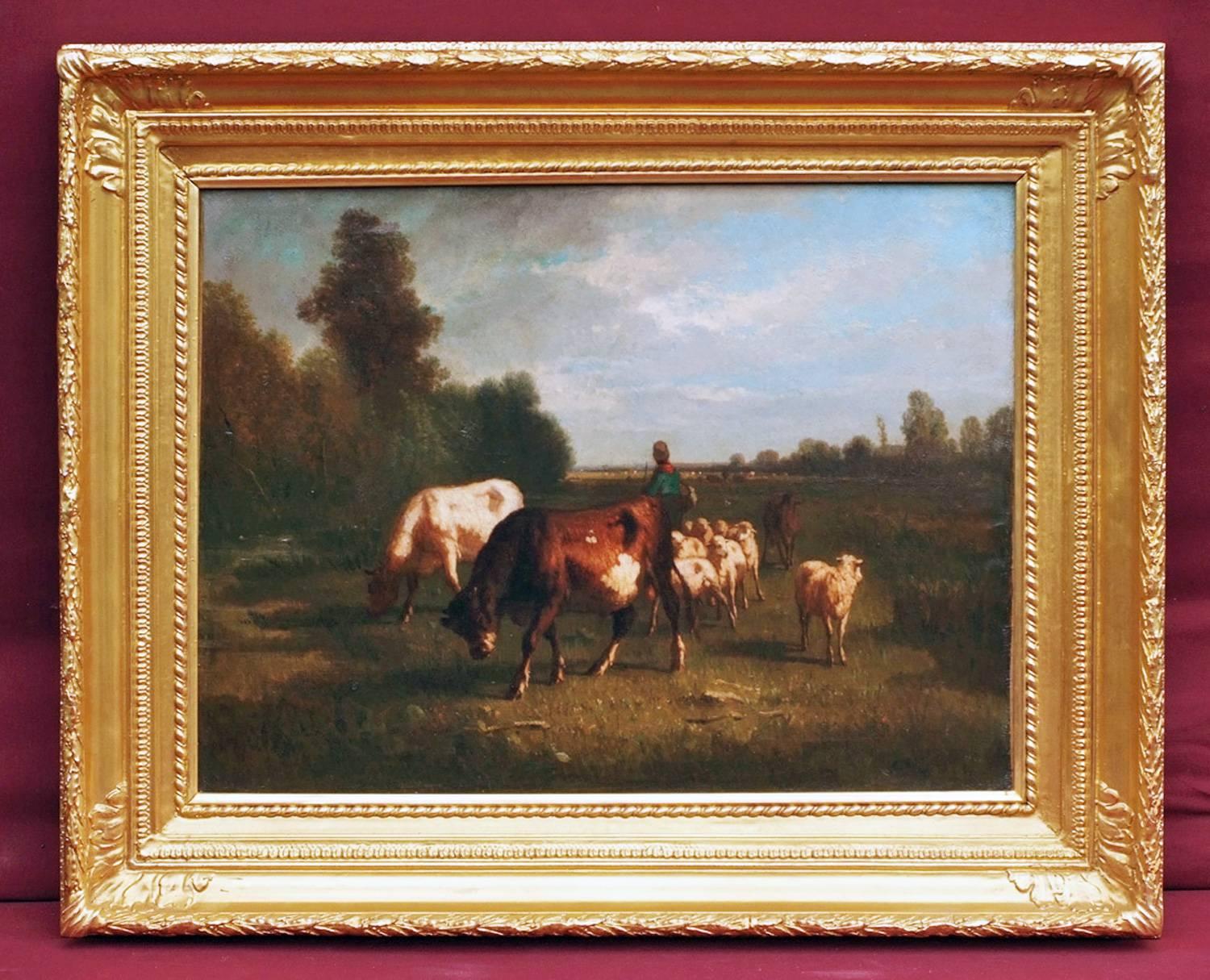Items Similar to Alfred De Breanski Jr. “Invergary Castle Loch Oich” Oil Painting
Want more images or videos?
Request additional images or videos from the seller
1 of 10
Alfred de Breanski Jnr.Alfred De Breanski Jr. “Invergary Castle Loch Oich” Oil Painting1900
1900
About the Item
Alfred de Breanski Jr, oil on canvas, "Invergary Castle, Loch Oich", Grazing sheep in the foreground and cattle in the background. A beautiful lake and mountain landscape with meadows, trees and snow capped peaks. The colors are vibrant.
Signed: A De Breanski B/L. Titled and signed verso.
Painting size: 18 inches x 24 inches
Framed size: 24.25 inches x 30.75 inches
Condition: Very Good with brilliant colors and no damage or restoration. Original frame with restorations.
AVANTIQUES is dedicated to providing an exclusive curated collection of Fine Arts, Paintings, Bronzes, Asian treasures, Art Glass and Antiques. Our inventory represents time-tested investment quality items with everlasting decorative beauty. We look forward to your business and appreciate any reasonable offers. All of our curated items are vetted and guaranteed authentic and as described. Avantiques only deals in original antiques and never reproductions. We stand behind our treasures with a full money back return if the items are not as described.
Alfred Fontville De Breanski Jr was a British artist known for painting landscapes of the United Kingdom in rich detail and vivid color. Born in 1877 in London, England, De Breanski began to study art at an early age, taught by his parents and an uncle—all were accomplished painters, most especially Alfred de Breanski Sr. The younger de Breanski attended the St. Martins School of Art before embarking on his own career painting naturalistic vistas of the countryside in Scotland and Wales. Similar to Antoine-Louis Barye and Alfred Barye, the de Breanksi father and son team worked within the same media with similar subject matter, and thus needed to distinguish their artworks from one another by a unique signature. The artist later travelled to France in the 1890s and was exposed to the Belle Époque style, and made the acquaintance of James Abbott McNeil Whistler. His artworks began to show the influence of Impressionism after his return to Britain, with prominent brushstrokes and great attention paid to light. De Breanksi died in 1957 in Tonbridge, England.
Please also consider Avantique’s eclectic collection of wonderful fine art paintings with artists such as Emile Albert Gruppe, Alphonse Mucha, Alfred De Breanski, Antoine Blanchard, and Marcel Dyf. We strive to collect the highest-quality paintings in exceptional condition.
- Creator:Alfred de Breanski Jnr. (1877 - 1955, British)
- Creation Year:1900
- Dimensions:Height: 24.25 in (61.6 cm)Width: 30.75 in (78.11 cm)Depth: 2 in (5.08 cm)
- Medium:
- Movement & Style:
- Period:
- Condition:
- Gallery Location:Dallas, TX
- Reference Number:1stDibs: LU2724214288192
Alfred de Breanski Jnr.
Alfred de Breanski, Jr is the son of renowned plein art landscape artist Alfred de Breanski, Sr, and began his career painting the Highlands of Scotland and scenes in England and Wales. Unlike the romantic realism of his father, Breanski, Jr ventured into a style of his own, influenced by the changing impressionistic and post impressionistic art of his time. His colors are more vibrant, and he chooses seascapes as well as landscapes with impressionistic pastels and light with often realistic foreground subjects. Alfred de Breanski, Jr, also known as Alfred Fontville de Breanski, studied at St Martin's School of Art, with his father and his Uncle Gustav, and painter of seascapes. His mother, Annie Roberts, was also a painter. De Breanski, Jnr spent time in France, where he developed his own style of landscape art distinctive from his father. Alfred Sr and his brother Gustav were sons of Polish immigrants into Britain, and established themselves as well known and sought after fine artists. They were known for travelling to the Highlands of Scotland, as well as Wales and the woodlands north of London to find their ideal landscape, and to paint in the open air, to capture the fleeting light in realistic detail. Alfred de Breanski, Jr followed this tradition, with more vivid greens, and with a flair all his own.
About the Seller
New to 1stDibs
Joined in the past six months.
No Reviews Yet
Vetted Seller
These experienced sellers undergo a comprehensive evaluation by our team of in-house experts.
1stDibs seller since 2024
Typical response time: 12 hours
- ShippingRetrieving quote...Ships From: Dallas, TX
- Return PolicyA return for this item may be initiated within 14 days of delivery.
More From This SellerView All
- Louis Aime JapyBy Louis Aimé JapyLocated in Dallas, TXLouis Aimé Japy (1840-1916) Oil on canvas Cows in river with village in background Signed lower right, Japy. Canvas 26” x 32” Overall in a period gilt frame 38” x 44”. Conditi...Category
1870s Barbizon School Landscape Paintings
MaterialsCotton Canvas, Oil
- Edmond Marie Petitjean French Landscape PaintingBy Edmond Marie PetitjeanLocated in Dallas, TXA wonderful and detailed landscape painting signed and inscribed oil on canvas painting by Edmond Petitjean, (French 1844-1925). Condition: Excellent. Looks like it was recently cle...Category
1880s Barbizon School Landscape Paintings
MaterialsPaint
- Emile Albert Gruppe “Nymphs” Oil Painting Nudes by a RiverBy Emile Albert GruppeLocated in Dallas, TXAn absolutely amazing post Impressionist painting with a cascade of bright colors showing nudes by a riverside with birch trees in the foreground and mountains in the background. Emi...Category
1970s Landscape Paintings
MaterialsPaint
- Daniel Kendrick Oil Painting “The Great Divide”Located in Dallas, TXDaniel Kendrick (Texas; 1948) oil on canvas painting of the Great Divide canyon with the sunrise morning ray reaching over the plateau to saturate the dessert foliage dew. Executed 2...Category
2010s Landscape Paintings
MaterialsPaint
- Emile Albert Gruppe Rocky Ocean ViewBy Emile Albert GruppeLocated in Dallas, TXEmile Gruppe (American, 1896-1978) Bass Rocks, Gloucester coastal rocky formations with a sea view with a sailboat in the distance. Oil on artist board. In an appropriate giltwood f...Category
1950s Landscape Paintings
MaterialsPaint
- Emile Albert Gruppe Rockport Massachusetts Ex-ChristiesBy Emile Albert GruppeLocated in Dallas, TXEmile Gruppe (American, 1896-1978) Motif #1, Rockport, Massachusetts. A cold , rainy and gray morning or evening in Rockport gethhing the nets in order to start the day of fishing an...Category
1940s Landscape Paintings
MaterialsPaint
You May Also Like
- Waiting by Jozef Israëls - Landscape oil paintingBy Jozef IsraëlsLocated in London, GBWaiting by Jozef Israëls (1824-1911) Oil on canvas 95.3 x 133.9 cm (37 ½ x 52 ¾ inches) Signed lower left, Jozef Israels A monumental painting by one of...Category
19th Century Barbizon School Figurative Paintings
MaterialsCanvas, Oil
- The Barn, Oil On Bord, Signed Jean-Charles Cazin, Barbizon School, 1865By Jean-Charles CazinLocated in Paris, FROil on panel representing a barn, signed JC Cazin on the lower left corner. Jean Charles Cazin (1840-1901) Born in Samer (his father, from Bologna,...Category
Late 19th Century Barbizon School Landscape Paintings
MaterialsOil
- Oil Painting 19th Century Cows Landscape BarbizonBy Antonio CortesLocated in Saint-Ouen, FRCORTES Antonio (1827-1908) Cows to pasture Oil on canvas signed lower left Old frame gilded with leaves Dim canvas : 54 X 65 cm Dim frame: 70 x 86 cm...Category
1860s Barbizon School Animal Paintings
MaterialsOil
- Barbizon School Lakeside Landscape With CastleLocated in Cotignac, FRAn oil on panel idyllic landscape by Boggio. The painting is signed bottom right. An idealised lakeside landscape view with a castle in the distance in the style of the Barbizon sch...Category
Mid-20th Century Barbizon School Landscape Paintings
MaterialsOil, Board
- Barbizon School Lakeside Landscape, The Shady Glen.Located in Cotignac, FRAn oil on panel idyllic landscape by Boggio. The painting is signed bottom right. An idealised lakeside landscape view of a shady glen in the style of the Barbizon school.Category
Mid-20th Century Barbizon School Landscape Paintings
MaterialsOil, Board
- The Forest, Large Barbizon School, Oil on Canvas Wooded LandscapeBy Emile Roux-FabreLocated in Cotignac, FRA French Barbizon School oil on canvas forest view by Emile Roux-Fabre. The painting is signed and dated bottom left with a dedication. A charming view of forest glade leading out to a valley landscape beyond. The artist has captured the magic feeling of the cool forest shade against the sunshine of the landscape beyond. The texture of the bark on the silver birch trees, the contrast of the leaves on the trees all framing the perspective to the view beyond. An extremely accomplished and atmospheric painting. The Barbizon school of painters was part of an art movement towards Realism in art, which arose in the context of the dominant Romantic Movement of the time. The Barbizon school was active roughly from 1830 through 1870. It takes its name from the village of Barbizon, France, on the edge of the Forest of Fontainebleau, where many of the artists gathered. Most of their works were landscape paintings, but several of them also painted landscapes with farmworkers, and genre scenes of village life. Some of the most prominent features of this school are its tonal qualities, colour, loose brushwork, and softness of form. The leaders of the Barbizon school were: Théodore Rousseau, Charles-François Daubigny, Jules Dupré, Constant Troyon, Charles Jacque, and Narcisse Virgilio Díaz. Jean-François Millet lived in Barbizon from 1849, but his interest in figures with a landscape backdrop sets him rather apart from the others. Jean-Baptiste-Camille Corot was the earliest on the scene, first painting in the forest in 1829, but his work has a poetic and literary quality which sets him somewhat apart. Other artists associated with the school, often pupils of the main group, include: Henri Harpignies, Albert Charpin, François-Louis Français and Émile van Marcke. In 1824 the Salon de Paris exhibited works of John Constable, an English painter. His rural scenes influenced some of the younger artists of the time, moving them to abandon formalism and to draw inspiration directly from nature. Natural scenes became the subjects of their paintings rather than mere backdrops to dramatic events. During the Revolutions of 1848 artists gathered at Barbizon to follow Constable's ideas, making nature the subject of their paintings. The French landscape became a major theme of the Barbizon painters. Millet extended the idea from landscape to figures — peasant figures, scenes of peasant life, and work in the fields. In The Gleaners (1857), for example, Millet portrays three peasant women working at the harvest. Gleaners are poor people who are permitted to gather the remains after the owners of the field complete the main harvest. The owners (portrayed as wealthy) and their laborers are seen in the back of the painting. Millet shifted the focus and the subject matter from the rich and prominent to those at the bottom of the social ladders. To emphasize their anonymity and marginalized position, he hid their faces. The women's bowed bodies represent their everyday hard work. In the spring of 1829, Jean-Baptiste-Camille Corot came to Barbizon to paint in the Forest of Fontainebleau, he had first painted in the forest at Chailly in 1822. He returned to Barbizon in the autumn of 1830 and in the summer of 1831, where he made drawings and oil studies, from which he made a painting intended for the Salon of 1830; "View of the Forest of Fontainebleau'" (now in the National Gallery in Washington) and, for the salon of 1831, another "View of the Forest of Fontainebleau"'. While there he met the members of the Barbizon school: Théodore Rousseau, Paul Huet, Constant Troyon, Jean-François Millet, and the young Charles-François Daubigny. During the late 1860s, the Barbizon painters attracted the attention of a younger generation of French artists studying in Paris. Several of those artists visited Fontainebleau Forest to paint the landscape, including Claude Monet, Pierre-Auguste Renoir, Alfred Sisley and Frédéric Bazille. In the 1870s those artists, among others, developed the art movement called Impressionism and practiced 'plein air' painting. In contrast, the main members of the school made drawings and sketches on the spot, but painted back in their studios. The Post-Impressionist painter Vincent Van Gogh studied and copied several of the Barbizon painters as well, including 21 copies of paintings by Millet. He copied Millet more than any other artist. He also did three paintings in Daubigny's Garden. The Barbizon painters also had a profound impact on landscape painting in the United States. This included the development of the American Barbizon school by William Morris Hunt. Several artists who were also in, or contemporary to, the Hudson River School studied Barbizon paintings for their loose brushwork and emotional impact. A notable example is George Inness, who sought to emulate the works of Rousseau. Paintings from the Barbizon school also influenced landscape painting in California. The artist Percy Gray...Category
Early 20th Century Barbizon School Landscape Paintings
MaterialsCanvas, Oil
Recently Viewed
View AllMore Ways To Browse
Antique Painting Decorative Arts
Painting Reproduction French
Antique Painting Art Collectibles
Jr Oil Paintings
French Castle Painting
Painting Of A French Castle
Antique Reproduction Paintings
Barbizon School Of Painting
Barbizon Oil Painting
Barbizon Oil
French Barbizon Painting
Antique Barbizon Painting
Barbizon Artists
Antique Oil Painting On Glass
Art Treasures Of England
Antique Oil Painting Of Castle
Louis De Belle
James B Painter






